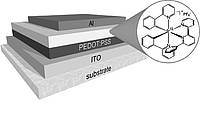 |
Long-Living Light-Emitting Electrochemical Cells – Control through Supramolecular Interactions
Dr. Henk J. Bolink and co-authors from the Instituto de Ciencia Molecular of the Universitad de Valencia (Spain) and the Department of Chemistry of the University of Basel (Switzerland), demonstrate a light emitting electrochemical cell (LEC) based on iridium(III) ionic transition-metal complex (iTMC) forming a caged structure. Light-emitting electrochemical cells are one of the simplest electroluminescent devices since they can function with a single transition-metal complex-based active layer. The device described in the article consists of layers deposited by solution-based techniques which are cost-effective and do not contain air-sensitive charge-injection layers. This offers major stability and increases the lifetime to 3000 hours which is sufficient for some applications.
The improvements are due to the use of the ionic iridium (III) complex with 2-phenylpyridine and 6-phenyl-2,2’-bipyridine ligands that form a caged structure protecting the metal complex from water molecules which may cause formation of degradation products detrimental to the luminescence.
As fabricated, these devices have a slow luminescence rise-time, typically of the order of several days at a driving voltage of 4V. This can be reduced to minutes by adding ionic liquids or by applying voltage pulses. The devices parameters observed are among the best for iTMC-based LECs: a maximum brightness of 290cd m-2, a power efficiency of 10.1 lm W-1 and a 4% external quantum efficiency at the peak wavelength in the orange (594 nm).
The concept used can be extended for the stabilization of other metal complexes and bring further improvement to organic light emitting devices, molecular solar cells and sensors.
The article has been published with an inside cover in Advanced Materials, 2008, 20, 3910-3913.

